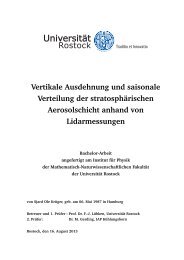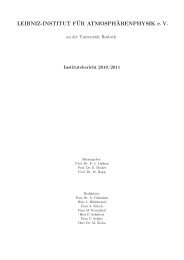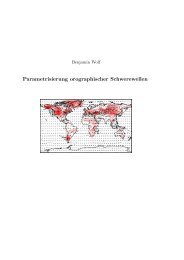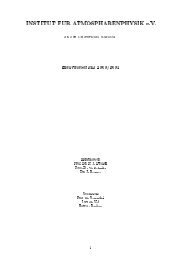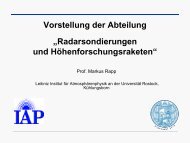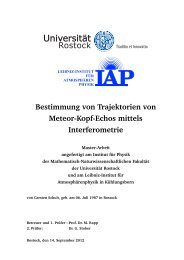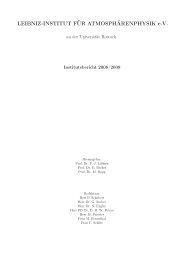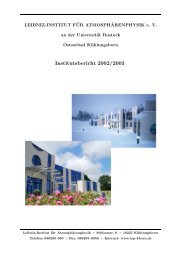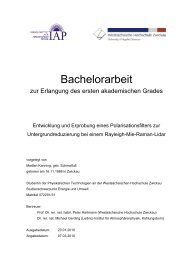Polar mesosphere summer echoes (PMSE): review of ... - HAL
Polar mesosphere summer echoes (PMSE): review of ... - HAL
Polar mesosphere summer echoes (PMSE): review of ... - HAL
You also want an ePaper? Increase the reach of your titles
YUMPU automatically turns print PDFs into web optimized ePapers that Google loves.
M. Rapp and F. J. Lübken: Review <strong>of</strong> <strong>PMSE</strong> 2603<br />
environment directly from the ground and observe the corresponding<br />
response <strong>of</strong> the <strong>PMSE</strong> layer. In Sect. 3 we proceed<br />
with an overview <strong>of</strong> our theoretical understanding <strong>of</strong> the relevant<br />
physical mechansms including a detailed description<br />
<strong>of</strong> the most recent progress. This latest understanding <strong>of</strong> the<br />
physics <strong>of</strong> <strong>PMSE</strong> is discussed in depth in Sect. 4 followed<br />
by our conclusions and an outlook where we try to identify<br />
important open issues for future investigations.<br />
2 Experimental facts<br />
2.1 Initial observations and basic physical problem<br />
At the end <strong>of</strong> the 1970s, VHF radars operating at frequencies<br />
<strong>of</strong> ∼50 MHz discovered very strong radar <strong>echoes</strong> from<br />
around the <strong>summer</strong> mesopause region at altitudes between<br />
∼80 and 90 km both at polar and mid latitudes (Ecklund<br />
and Balsley, 1981; Czechowsky et al., 1979). The first long<br />
term data set covering observations at Poker Flat, Alaska<br />
(65 ◦ N) between February 1979 and December 1980 revealed<br />
a strong seasonal variation <strong>of</strong> both the observed echo power<br />
and the altitude range where the <strong>echoes</strong> were observed (Ecklund<br />
and Balsley, 1981). Figure 2 shows the time averaged<br />
altitude pr<strong>of</strong>iles <strong>of</strong> signal to noise ratio (SNR) for typical<br />
<strong>summer</strong> and winter periods taken from this study. Evidently,<br />
during the <strong>summer</strong> months the average signal peak is located<br />
considerably higher (i.e., at ∼86 km) than during winter<br />
time, where only weak <strong>echoes</strong> (average SNR ratios ∼5 dB)<br />
are received from altitudes below ∼75 km. During <strong>summer</strong><br />
time, however, the <strong>echoes</strong> are extremely strong reaching a<br />
maximum average SNR <strong>of</strong> ∼30 dB. Due to their predominant<br />
appearance in the polar regions these strong <strong>echoes</strong> are<br />
commonly called polar <strong>mesosphere</strong> <strong>summer</strong> <strong>echoes</strong> or <strong>PMSE</strong><br />
(Röttger et al., 1988; Hoppe et al., 1988).<br />
Radar waves are scattered by irregularities in the refractive<br />
index which at altitudes around 85 km is effectively determined<br />
by the electron number density (e.g., Sato, 1989,<br />
page 23–25). In general, one distinguishes between incoherent<br />
scatter (or Thomson scatter) which is due to the thermal<br />
random motion <strong>of</strong> the electrons and coherent scatter,<br />
i.e., the scatter at ordered structures in the electron density<br />
distribution. Coherent scatter only occurs when the refractive<br />
index irregularity spectrum possesses significant spectral<br />
power at scales around the radar half wavelength (=<br />
Bragg condition for monostatic radars) which is 3 m for a<br />
50 MHz radar (Tatarskii, 1971). The irregularities leading<br />
to the weak radar backscatter outside the polar <strong>summer</strong> season<br />
at altitudes below say ∼75 km have been traced back to<br />
neutral air turbulence (Woodman and Guillen, 1974; Balsley<br />
et al., 1983; Røyrvik and Smith, 1984) which in turn is<br />
generated by breaking gravity waves propagating upwards<br />
from the troposphere (note though that recent experimental<br />
evidence <strong>of</strong> so called ‘polar <strong>mesosphere</strong> winter <strong>echoes</strong>’ indicates<br />
that at least some <strong>of</strong> these <strong>echoes</strong> at lower altitudes<br />
Fig. 3. Idealized power spectrum <strong>of</strong> a passive turbulent tracer θ<br />
for typical mesospheric conditions. The inertial and viscous subranges<br />
are characterized by a wavenumber dependence proportional<br />
to k −5/3 and ∼k −7 , respectively. The upper ordinate converts<br />
wavenumbers to lengths. The grey dashed line indicates the inner<br />
scale (see text for details) and the red dashed line indicates the<br />
Bragg scale <strong>of</strong> a 50 MHz radar.<br />
may not be understandable in the scope <strong>of</strong> pure turbulent activity;<br />
Kirkwood et al., 2002a, 2003). However, early efforts<br />
to explain the significantly stronger <strong>echoes</strong> from the <strong>summer</strong><br />
polar mesopause region by neutral air turbulence led to<br />
a paradox that was already identified in the early work on the<br />
subject (Balsley et al., 1983): In Fig. 3 we present a typical<br />
power spectrum <strong>of</strong> a tracer (like neutral air density fluctuations)<br />
for turbulent motions in the middle atmosphere. This<br />
power spectrum reveals two distinct parts. The first part is<br />
marked by a wavenumber dependence <strong>of</strong> k −5/3 and is called<br />
the inertial subrange, because at these scales the flow is dominated<br />
by inertial forces. The second part <strong>of</strong> the spectrum is<br />
called the viscous subrange and is characterized by a much<br />
faster drop <strong>of</strong>f <strong>of</strong> the spectral power, i.e., it is proportional<br />
to ∼k −7 . In this subrange, the tracer variance is effectively<br />
destroyed by molecular diffusion (e.g., Heisenberg, 1948).<br />
Note that the absolute power <strong>of</strong> the tracer variance strongly<br />
depends on the background gradient <strong>of</strong> the tracer distribution,<br />
i.e., at a given length scale, the tracer fluctutaions are<br />
the larger the larger the background gradient is (in the extreme<br />
opposite case <strong>of</strong> a zero background gradient, small<br />
scale fluctuations can certainly not be created by the turbulent<br />
eddies). From this figure, it is evident that in order to satisfy<br />
the Bragg criterium, the radar half wavelength must be located<br />
in the inertial subrange <strong>of</strong> the turbulent power spectrum<br />
since for smaller scales, i.e., in the viscous subrange, irregularities<br />
practically do not exist. The smallest scale to which<br />
the inertial subrange extends, depends on two quantities: the<br />
turbulence strength expressed by the turbulent energy dissipation<br />
rate ɛ (= the rate at which turbulent kinetic energy is<br />
dissipated into heat) and the kinematic viscosity ν which parameterizes<br />
the strength <strong>of</strong> molecular diffusion. A minimum<br />
necessary turbulent energy dissipation rate can be estimated<br />
by equating the inner scale l H 0 =9.9·(ν3 /ɛ) 1 4 (= the transition<br />
www.atmos-chem-phys.org/acp/4/2601/ Atmos. Chem. Phys., 4, 2601–2633, 2004



